Ways To Help Ecommerce Clients Prepare for the Holiday Season

Shopping trends suggest holiday sales will come back strong this year. The only thing is, they have some new obstacles to contend with—and we are in a unique position to help them out.
Usually around this time of year, ecommerce analysts reflect on the previous holiday shopping season in order to make predictions for the coming one. The only problem is that last year’s holidays were, um, not normal. So all they can really go on is this year’s shopping activity and trends.
Now, 2021’s sales figures so far appear to be approaching what we once considered “normal.” While experts predict a healthy return to holiday shopping this season, they don’t have as shiny an outlook on the fulfillment side of things, thanks to current supply-chain issues like labor shortages and shipping delays.
Does knowing this change anything? After all, it’s not like an ecommerce company or their designer can really do anything to improve the supply chain.
Much like how we use design to elicit certain emotions and responses from shoppers, we can do the same thing when it comes to the upcoming shopping season. If we know what the challenges are, we can design specifically for them and try to remove as much of the stress shoppers might otherwise feel when trying to buy gifts, snag deals, etc.
Ways To Prepare Ecommerce Sites—and Shoppers—for the 2021 Holidays
You already know what good ecommerce UX looks like. Now let’s look at some 2021-specific design strategies you can employ to improve the shoppers’ experience.
1. Update Your Store and Product SEO
Years ago I attended a webinar where a highly successful entrepreneur was interviewed. I can’t remember exactly what his business did, but I remember what it was that put it on the map:
SEO.
Basically what happened was that he noticed all of these “Top” listicles going out just before the new year every year. The Best Ski Boots for 2022. 5 New Web Design Trends for 2022. The Top Places to Move in 2022. That sort of thing.
He also noticed that the pages that ranked at the top of the search results page were well-written and had been written earlier than the others. We already know that the age of content affects how well a page ranks in search, so this isn’t that much of a surprise. It’s just something that people don’t often think about when publishing these new year posts. That said, it worked to this entrepreneur’s advantage.
He put together a really awesome page centered around a popular new year search query and he ended up dominating search results immediately because no one else had thought to tackle it yet.
While a new year optimization won’t make sense for what we’re talking about today, holiday shopping-related terms do.
What I’d suggest you do is spend some time in Google Trends. Set the timeframe to September 2019 to today. Then enter the holiday-related search term that’s relevant to your client’s ecommerce business.
Let’s use the example of “Christmas gifts”:
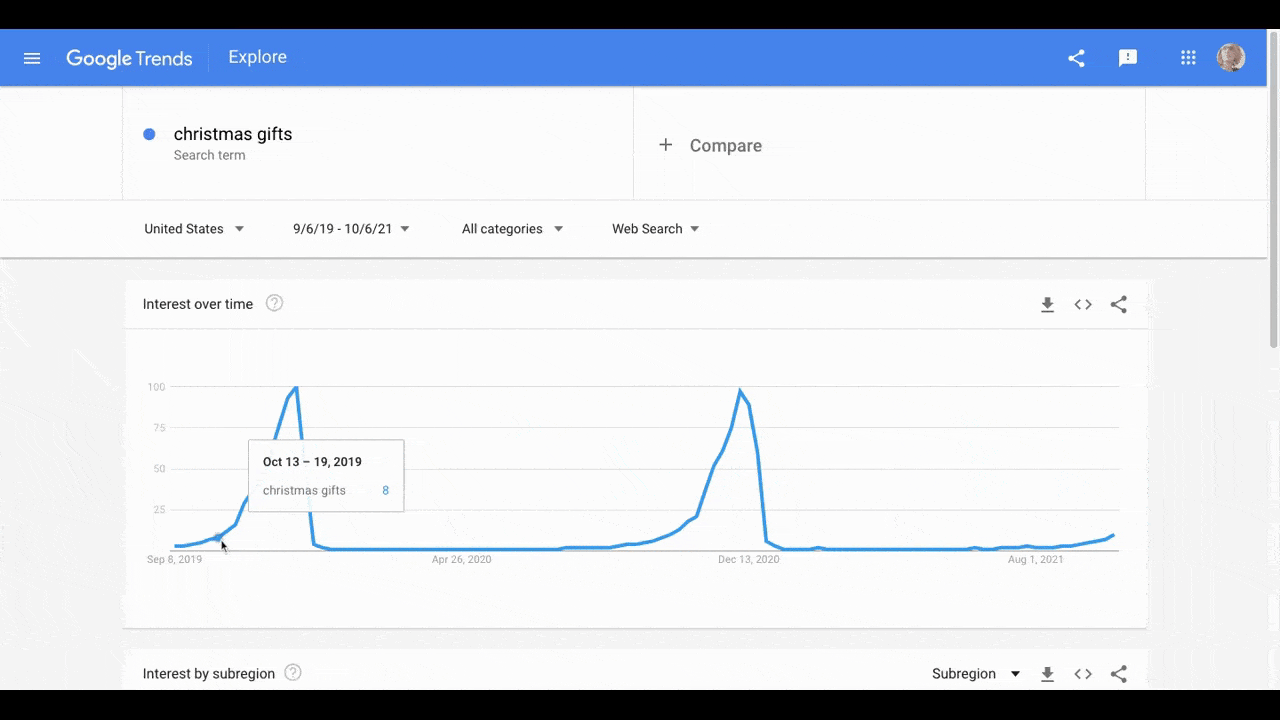
By the way, you can use this tool to measure all sorts of relevant search queries:
- “Best holiday gift for [mom/husband/daughter/best friend/dog]”
- “Black Friday [product] deals”
- “Top gifts in 2021”
- “Holiday deals 2021”
- “Thanksgiving meal prep”
The first thing you want to do is look for when the search term starts to trend, no matter how small that uptick is. It looks like it usually starts around the beginning of September in the United States. This year, however, it began earlier—around the last couple of weeks in August.
The next thing to look at is when it really starts to pick up speed. The last two years it happened around mid-October. This year, however, it hit “10” a week earlier. Based on these trends, it’s safe to say that interest in holiday gift shopping is starting much earlier.
By following these trends, you’ll know when the best time is to start promoting specific sales, announce Black Friday deals, or to drum up interest in popular holiday gift purchases through your SEO. I wouldn’t apply it to everything, though. That’s way too big of a task. I’d just update the home page SEO as well as top category and product pages.
One other thing to pay attention to is when those searches come to a halt. You want the ecommerce site and your top product pages to be optimized for these and related search terms when people are actually looking for them. When they’re not, the SEO emphasis should go back to what it normally is.
In other words, your SEO, ecommerce copy and product descriptions should always match your shoppers’ intent at that very moment.
2. Redesign the Home Page To Look More Seasonal
Here’s some interesting data from Criteo’s 2021 Holiday Shopping Predictions:
“Our data shows that on average, from first touchpoint to purchase, it takes a new customer two weeks in the US—and even longer in other countries—to make their Black Friday purchase decision. For those with the longest path to purchase, it can be as much as four to nine weeks from first touchpoint to purchase, with US consumers on the shorter end and German and Japanese shoppers on the longer end.”
So, when we talk about designing ecommerce sites to appeal earlier on in the season to shoppers, we’re really doing it for two reasons:
- To get in front of people who do their shopping early
- To get in front of people who take weeks to research and scope out their options before making a purchase
Two to nine weeks is a pretty long time period to be advertising your Black Friday deals or holiday gifts. If it makes sense to do so, though, you can start running those promos as early as late September or early October. That’s what The Honey Baked Ham Co. is doing right now:
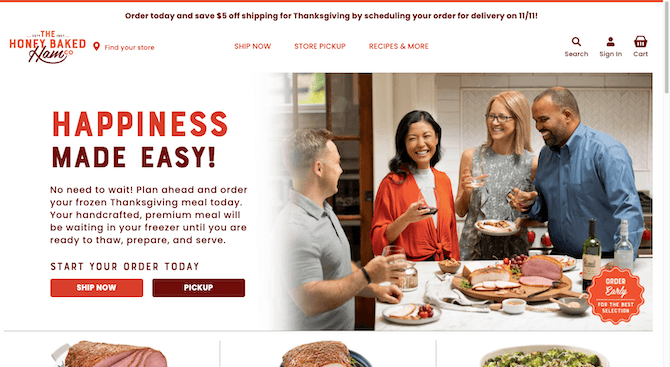
The top three-quarters of the home page is dedicated to Thanksgiving orders and gifting. For this kind of ecommerce site, it makes complete sense to do this.
Think about what it’s like going to the grocery store in the weeks leading up to Thanksgiving—you’re lucky if you can find a turkey, let alone one the size or quality you were hoping for. Check out the “Order Early for the Best Selection” seal on the right of the hero image. It’s there because the company knows this is exactly what people go through around Thanksgiving.
Of course, advanced promotions don’t always make sense. In that case, all you need to do is dress up your site for the season.
For shoppers actively researching items to buy when the big sales drop, they should see the seasonal redesign as a sign that there’s more to come in November and December. For those who are shopping for other reasons, the seasonal design might encourage them to start thinking about their holiday shopping earlier.
Omaha Steaks is one such food retailer doing this:
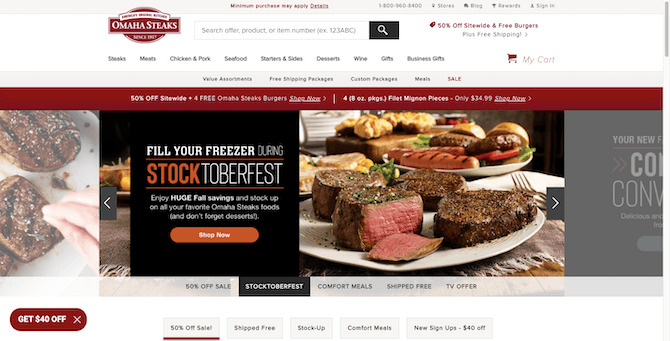
The promotions advertised in the home page carousel are specifically for fall:
- 50% Off Sale
- StockToberfest
- Comfort Meals
The comfort food imagery and relevant copy should definitely get shoppers curious about what sorts of sales they’ll be running in a month or so, even if they choose not to take advantage of these ones now.
Just keep in mind that this isn’t about pressuring people to buy or to buy more than they planned to over the holidays. It’s about designing the site to capture those inevitable sales ahead of schedule, so you can reduce the pressure on fulfillment and shipping providers. As well as on your shoppers that may find out too late that they didn’t make their purchases early enough.
3. Add Education to the Shopping Experience
Building upon the statistic regarding how long a purchase can take during the holiday season, I want to encourage you to look at the space below your products. Typically what we see there are a bunch of upsells (“Commonly Bought Together”) and cross-sells (“You May Also Like”).
I don’t know if that’s what 2021 holiday shoppers really need. After the past year, I expect many shoppers will be more conservative with their purchases, especially because now they know you can never be certain about what’s around the corner.
While it’s fine if you reserve some space for upsells and cross-sells, I think that space is better used for education. Customer reviews and ratings are a must as they’ll help remove remaining doubts and concerns from their decision-making process. But also I think relevant blog posts and tutorials would be a great addition to this space as a value-add.
Let me show you some examples of ecommerce sites doing this right now.
Loft includes a “Ways to Wear It” section beneath its product images and descriptions:
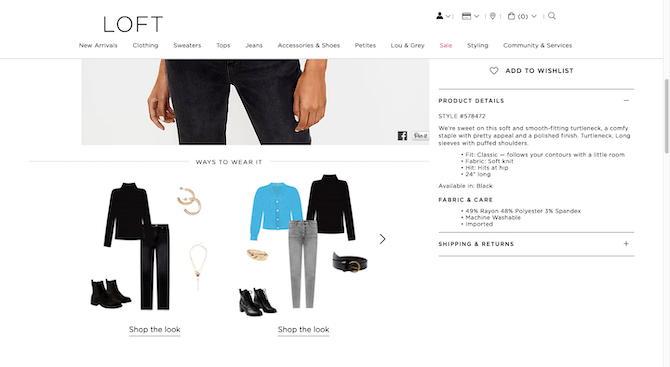
Although this won’t direct them to any educational blog posts or videos, the section on its own provides extra value. Sure, it’s promotional in nature as it’s directing shoppers to other items in the Loft store. However, it’s also inspirational. Many shoppers might already have grey jeans or black pants they could nicely pair with this black turtleneck and this section gives them the confidence to buy this new item of clothing to round out their wardrobe.
Another way to add value would be to include relevant blog post links below the product as John Henric does:

The product pages on this site don’t overwhelm shoppers with upsell and cross-sell images and links. Instead, the Style Guide blog and Sizing Guide links are placed at the very bottom of each page. This way, shoppers can focus on making high-quality purchases instead of on the quantity of items they make in their purchase.
One other thing you can do here is to include instructional videos. This is something that Solo Stove does really well:

There are two videos that appear directly below this stove product. The first is technically a promotional video for the Solo Stove Yukon. However, if you watch the video, you’ll see that shoppers get a better sense for the various use cases for the stove as well as its actual size since they see it within the context of people standing and sitting around it.
The other video is an instructional video. Chris from Solo shows people how to light the stove in under three minutes.
4. Encourage Shoppers To Buy Earlier With Special Notices
We know that fulfillment, shipping and labor are going to be problematic this holiday season. And by we, I mean people paying attention to ecommerce holiday trends reports and design blogs like this one. Holiday shoppers, however, might not.
So, if they drag their feet on making a purchase, and then it’s no longer available or it arrives too late, who do you think they’re going to blame? Even if they see articles about delays with the post office and fulfillment centers, they’re not going to care. They don’t want to hear any excuses from the retailer. And that’ll likely be the end of the relationship with them, too.
You can’t afford to have external circumstances ruin the relationships that your ecommerce clients have with their customers, both new and long-time loyal ones. One way to try and preserve this over a trying holiday shopping season is by being very transparent with shoppers.
Let them know if there are shipping delays. Strongly encourage them to order ahead of time (like Honey Baked Ham is doing right now). And let them know when inventory is in high demand and running low like Nectar Sleep has done here:
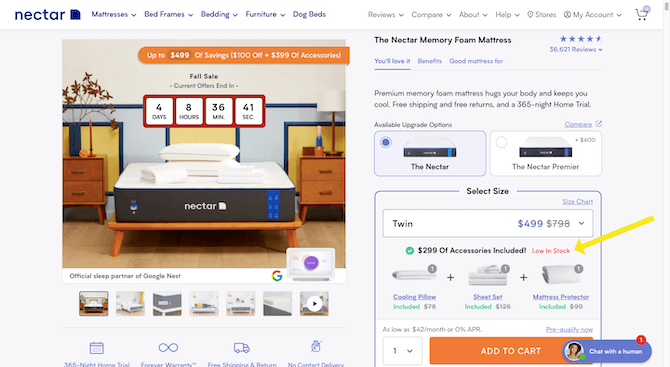
Nectar Sleep takes it a step further and I think it’s the right move, too. Here’s what shoppers see after they add The Nectar Mattress to their shopping cart:

There is an animated timer at the top of the page. It gives shoppers nine minutes to complete their purchase before the item is removed and added back to the inventory count.
While I don’t believe in pressuring shoppers to buy out of urgency, I do believe that transparency about product availability is important right now. It realistically could make or break many shoppers’ experiences with retailers this holiday season.
This timer, in particular, is useful because it forces shoppers to take their purchases more seriously. I know that some shoppers try to play games in the shopping cart—and it works on some sites. They’ll leave items in their cart for a few days until the inevitable “We miss you! Here’s 20% off so you can buy that item you left in your cart” email comes through.
By not allowing them to play those games, ecommerce companies can maintain better control over their inventory, which means they can provide better and more accurate service to their shoppers. Also, they’ll have a bit more control over when their customers do their shopping and, perhaps, prevent issues down the road with fulfillment and shipping that could interfere with their experience.
Wrap-up
I realize this is a different way of looking at ecommerce websites and design. However, no one really knows what the future holds right now.
There are some things for certain with regards to 2021, and so you can use that information to help refine your ecommerce strategies. As for what you do in the future, if you run into similar obstacles, you’ll have a solid tried-and-tested game plan ready to go.

Suzanne Scacca
A former project manager and web design agency manager, Suzanne Scacca now writes about the changing landscape of design, development and software.
